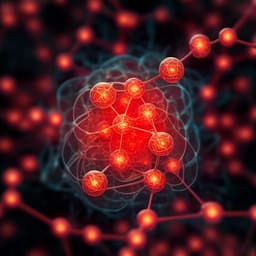
Engineering and Technology
Wide-range and high-accuracy wireless sensor with self-humidity compensation for real-time ammonia monitoring
W. Lv, J. Yang, et al.
This innovative research showcases a wireless LC chemical sensor that utilizes platinum-doped partially deprotonated-polypyrrole for precise ammonia detection, developed by Wen Lv, Jianhua Yang, Qingda Xu, Jaafar Abdul-Aziz Mehrez, Jia Shi, Wenjing Quan, Hanyu Luo, Min Zeng, Nantao Hu, Tao Wang, Hao Wei, and Zhi Yang. The sensor not only achieves real-time response but also distinguishes between humidity and ammonia, making it a crucial tool for various applications.
~3 min • Beginner • English
Introduction
Portable biomarker detection enables on-site, real-time chemical analysis for applications such as disease diagnosis, food freshness evaluation, and hazardous leakage warning. Ammonia (NH3) is a key biomarker: elevated exhaled NH3 correlates with kidney disease; NH3 and other total volatile basic nitrogen (TVB-N) compounds indicate meat spoilage; industrial NH3 leaks pose health and environmental risks. Conventional analytical instruments (e.g., GC-MS) are accurate but bulky, expensive, slow to start, and require trained personnel. Fluorescent sensors are mobile but largely qualitative, and typical chemiresistive devices need wired acquisition, limiting field deployment. Humidity strongly interferes with NH3 sensing, and external humidity-compensation adds complexity. Wireless passive LC sensors can supply energy, transduce, and transmit signals without wiring, but they suffer from periodically varying operating voltage, higher background noise, and poor low-concentration performance compared to wired devices. Existing LC NH3 sensors generally have ppm-level detection limits, and current sensitization strategies (heterojunctions, Schottky junctions) struggle to balance adsorption-charge transfer dynamics, conductivity, and semiconductor type, limiting sensitivity and upper detection limits. Multi-parameter readouts from a single LC device (frequency f and return loss S11) could enable humidity compensation without extra sensors, but suitable sensing materials with discriminative transduction are lacking. This work addresses these gaps by engineering platinum-doped, partially deprotonated polypyrrole (Pt-PPy and PPy) to tune impedance for stronger wireless signals, enhance NH3 adsorption and charge transfer while maintaining p-type behavior, and leverage distinct S11 (NH3) versus f (humidity) responses for self-humidity compensation.
Literature Review
Prior works show: (i) GC-MS enables accurate NH3 identification but is impractical for field use due to size, cost, startup time, and operator requirements. (ii) Fluorescent NH3 devices are mobile yet largely qualitative (colorimetric). (iii) Chemiresistive sensors need wired instrumentation and are significantly affected by humidity; compensation with extra humidity sensors increases system complexity. (iv) Wireless passive LC sensors are attractive for real-time, wiring-free operation but have higher background noise and periodically varying voltages that limit sensitivity; reported LC NH3 sensors typically have ppm detection limits, lagging ppb-level wired sensors. (v) Sensitization via heterojunctions or Schottky junctions can improve adsorption/charge transfer but often compromises conductivity or semiconductor type, limiting radio-frequency performance and upper detection ranges (often only several hundred ppm). (vi) Multi-parameter LC sensing has been proposed (e.g., multiplexed sensors or branching inductors), but using a single LC sensor’s S11 and frequency to separately transduce NH3 and humidity without cross-talk has not been demonstrated due to insufficient material specificity. These gaps motivate a material-system co-design that simultaneously boosts RF performance, sensitivity, range, and built-in humidity compensation.
Methodology
Device and sensing concept: A flexible LC resonator integrates a square inductor (L), interdigital capacitor (C), and a Pt-PPy/PPy chemiresistor (R) on a polyimide substrate (~12.5 µm). The reader antenna wirelessly couples energy and reads the S11–frequency curve. NH3 exposure modulates the sensing film conductivity, changing series resistance Rs and thus S11. Humidity alters effective permittivity and capacitance C0, shifting the resonant frequency f. Distinct transduction: S11 primarily tracks NH3 via resistive change; f primarily tracks humidity via dielectric change, enabling self-humidity compensation.
Materials design and simulations: Polypyrrole (PPy) oxidation state was chemically tuned to broadly adjust conductivity and LC impedance. DFT (PBE-GGA, optPBE-vdW, 500 eV cutoff; 3Py oligomer model; 2×1×1 and 4×2×1 k-point meshes; convergence 1e-5 eV and 0.02 eV/Å) showed that reducing hole concentration widens the PPy band gap from 0.04 eV to 2.71 eV, supporting wide-range conductivity tuning for S11 enhancement. Transition metal doping (Cu, Pd, Pt) on partially deprotonated PPy was assessed via DFT for NH3 adsorption energy (ΔEads) and charge transfer (Q). Pt-PPy hybrids displayed the strongest interaction with NH3 (ΔEads ≈ −3.99 eV, Q ≈ −0.4 e), far exceeding undoped PPy and many reported materials, while maintaining p-type behavior expected to give a positive S11 shift upon NH3 exposure.
Synthesis: PPy was prepared by Fe3+-mediated oxidative polymerization (pyrrole + SDS in DI water, FeCl3 addition at 5 °C, 3 h; washing and drying). Pt-PPy hybrids were synthesized by dispersing PPy in ethanol, then adding H2PtCl6 and NaBH4 to simultaneously form Pt nanoparticles (NPs) and partially deprotonate PPy, yielding Pt-PPy• and PPy0 nanohybrids. Variants with different Pt loadings were made by adjusting precursor volumes (e.g., 5 Pt-, 10 Pt-, 30 Pt-PPy). The dispersions were spray-coated onto IDEs through a mask and vacuum-dried.
Fabrication: LC resonators were made via flexible PCB processes: Cu seed sputtering on polyimide (~12.5 µm), ~9 µm Cu electroplating and patterning, then ~2 µm Ni and ~0.025 µm Au layers deposited. The sensing film thickness was ~56.1 µm.
Characterization: Morphology and structure by SEM/TEM; elemental mapping; HRTEM and SAED confirmed ~15 nm Pt NPs with Pt(111) lattice and single crystallinity. XPS (C 1s, N 1s, Pt 4f) evidenced charge transfer between Pt NPs and PPy and coexisting Pt0/Pt2+. FTIR and Raman indicated reduced polaron/bipolaron concentrations and strong Pt–PPy interactions; conductivity measurements showed PPy conductivity 5.1× higher than 10 Pt-PPy, confirming target conductivity reduction. Device EM simulations used HFSS (boundary 300×300×300 mm3, lumped port excitation).
Measurements: RF readout via a network analyzer recorded S11–f under varying distances and bends; gas sensing used a custom chamber with wireless interrogation; response defined as (S11_gas − S11_air)/S11_air. NH3 concentration range from 125 ppb to 2000 ppm was tested; humidity varied 30–90% RH. Selectivity assessed against 15 gases; robustness via bending (200 cycles, R=5 mm), repeatability (five cycles at 100 and 2000 ppm), and stability (40 days). Self-humidity compensation used the linear f–humidity calibration (f = 517.7 − 0.5×RH in MHz) to correct NH3 readings without an external humidity sensor.
Application demonstrations: A smart package (airtight ~3 L container with embedded sensor) coupled to a mini VNA tracked TVB-N from shrimp, beef, and chicken during spoilage at 7 °C and 20 °C; lab instrument (LD-SP01) provided TVB-N references to derive calibration curves and compare readings. A POC tester (0.25 L chamber + device) with a mini VNA analyzed simulated breath (1000–5000 ppb NH3) with timing and accuracy assessed. An early-leak detection setup used micro-syringe drips (0.1 µL) of NH3 solution to map response patterns for leak localization and measure leak frequency (0.3–1.5 Hz).
Key Findings
- Wireless signal enhancement: Chemically tuning PPy conductivity via partial deprotonation and Pt doping increased S11_air by up to 180% versus PPy-only devices; 10 Pt-PPy device achieved S11_air ≈ −5.6 dB with minimal f variation (Δf_max ≈ 2.9%).
- Operating robustness: 10 Pt-PPy device maintained function under strong bending (detectable radius limit R1 = 5 mm vs 29 mm for PPy) and longer read distances (d1 = 21.5 mm vs 5.5 mm for PPy). Operating frequency <500 MHz enables use with mini VNAs.
- NH3 sensitivity and range: 10 Pt-PPy device showed ~16.2× higher response to 100 ppm NH3 than PPy; detection limit 125 ppb (vs 10 ppm for PPy) and unprecedented wireless LC sensing range 125 ppb–2000 ppm with monotonic, dosimetric response. Lower background noise than PPy aided low-ppb detection.
- Fast dynamics and reversibility: Rapid response time ~19 s at high NH3 concentration (2000 ppm), outperforming many reported NH3 sensors; full recovery from 125 ppb to 2000 ppm. In situ Raman confirmed reversible electron doping/dedoping (bipolaron peak disappearance/reappearance).
- Discriminative dual-parameter transduction: NH3 affected S11 but not f, while humidity strongly shifted f. Linear humidity calibration f (MHz) = 517.7 − 0.5×RH (%), enabling self-humidity compensation. At 100 ppm NH3 and 90% RH, post-compensation concentration deviated by only a few ppm from the true value.
- Selectivity, robustness, stability: Stronger response to NH3 than to other tested gases; noticeable but smaller responses to TVB-N amines (e.g., triethylamine). Stable performance after 200 bending cycles, five exposure cycles (100 and 2000 ppm), and after 40 days in ambient conditions.
- Application performance: Smart package readings of TVB-N for shrimp, beef, and chicken closely matched laboratory instrument values across 7 °C and 20 °C storage. Breath analysis accurately quantified 1000–5000 ppb NH3 (max deviation ~500 ppb at 3000 ppb) with detection time <76 s and detection limit 1000 ppb in the POC setup. Early leak detection localized 0.1 µL NH3 leaks and measured leak frequency across 0.3–1.5 Hz.
Discussion
The study targets real-time, accurate NH3 sensing in portable scenarios by overcoming LC sensor limitations in sensitivity, range, and humidity interference. By co-designing the sensing material and RF transduction, the device leverages PPy’s chemically tunable conductivity to optimize LC impedance and S11, while Pt doping dramatically enhances NH3 adsorption and charge transfer without altering p-type behavior. This results in strong, reliable wireless signals and a wide linear dynamic range from ppb to thousands of ppm. Critically, the decoupled transduction pathways—S11 for NH3 (resistive change) and f for humidity (dielectric change)—enable self-humidity compensation from a single device, removing the need for an auxiliary humidity sensor and reducing system complexity and cross-talk. The combination of enhanced RF performance, sensitivity, fast response, mechanical robustness, and built-in humidity calibration provides accurate NH3 quantification across diverse environments. Demonstrations in food freshness monitoring (TVB-N), breath NH3 assessment (POC diagnostics), and early industrial leak detection highlight practical relevance and the potential for distributed, wireless sensing networks in real-world settings.
Conclusion
This work introduces a wireless passive LC sensor using platinum-doped, partially deprotonated polypyrrole to simultaneously boost RF transmission (up to 180% S11 improvement), achieve p-type, high-adsorption/charge-transfer NH3 sensing, and enable self-humidity compensation via dual-parameter readout (S11 for NH3 and frequency for humidity). The device attains an exceptional wireless NH3 detection range (125 ppb–2000 ppm), rapid response (~19 s), mechanical robustness, and strong agreement with laboratory standards in food freshness tests. Portable implementations for breath analysis and early leak detection demonstrate fast, accurate, and wide-range operation with minimal instrumentation. Future work should expand testing cohorts and environments to strengthen statistical confidence, explore long-term field deployments, and investigate material/system optimization for broader analyte selectivity and networked sensing scalability.
Limitations
The study acknowledges limited sample sizes and controlled testing environments for application demonstrations; broader, long-term field studies with more samples are needed to validate reliability and generalizability. Humidity dampens S11 and responses, although the proposed self-compensation mitigates accuracy loss. Material variability (e.g., Pt loading, film thickness) and environmental factors could affect calibration and should be further standardized for mass deployment.
Related Publications
Explore these studies to deepen your understanding of the subject.







